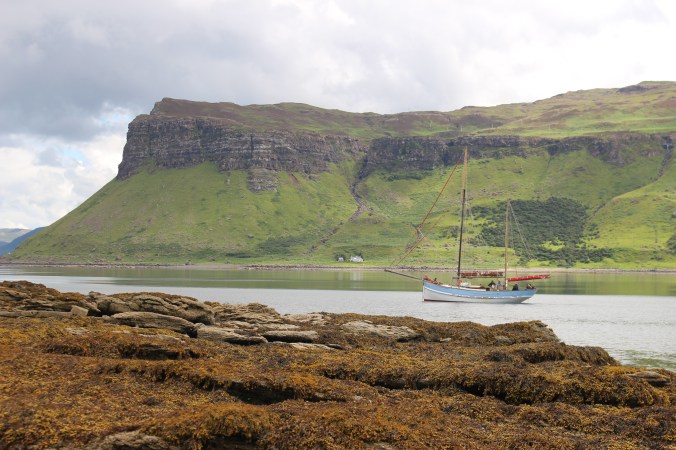Last month I spent a day with Meryl at the Tiroran forest eagle hide. With the remaining chick on the nest, all age groups got a good view of it through the telescope as it was stretching its wings and moving around the nest. There was lots of great information told by Meryl to keep everyone entertained and learning new things about White tailed eagles. Thanks for letting me help for the day again Meryl.
As part of the Ross of Mull Historical Centre’s project to survey old townships, I went along to help with the walk over survey at Ardchiavaig with Argyll Archaeology. The day involved walking over a mapped area of the township identifying the buildings and wall structures and measuring each one to start getting an overall view of the site. On the day we were also joined by Alasdair Satchel who is a local documentary maker who was making a short documentary about the project and doing film making and editing with young people throughout the week. BBC Alba also came out on site to get some footage for a news segment on An Là.
We took a group of young people who were over on Mull as part of The Stevenson Way, to Shiaba for a walk to look at the local nature. We firstly had a look at the Mariota Stone at Kilvickeon Church then the group navigated their way to Shiaba township. On the way, we saw the sheep fank, sundew plants in the bog and my first golden eagle on Mull just above our heads.

This year’s Practical plants day was a bit windy and wet but we managed to compress it all into the hall and everything ran smoothly. It was a fun filled day of a variety of plant based workshops such as wool dyeing and herbal remedies, talks and locally sourced/cooked food was on the menu for lunch. We also had our children’s table with activities such as seed bombs, insect homes, paper making and rainsticks. In the afternoon I got the chance to do the cooking workshop where we made dandelion shortbread, elderflower marshmallows and egg muffins with different herbs. Thank you to everyone who made the day such a success.
Uisken games started off a bit cool and cloudy but as the day went on the clouds cleared and everyone had fun. There was stalls of burgers, RNLI, first responders and ourselves with scavenger hunt and badge making. The games for all ages got underway and there was the raft race at the end.
The next day, as well as being World Rangers Day it was also our ‘Survivor Camp’ event at Tiroran Forest for 9-15 year olds. With my forest school experience, I felt very at home and the afternoon was enjoyed by all. The three hours went by so fast and all the young survivors got a chance at making their own den structures, tracking for animal prints and making a cast of the ones they found as well as collecting and filtering water to use for hot chocolate. They all managed to make their own bows and arrows for target practice, light their own fires in the Kelly kettles with flint and steel and enjoyed an energetic game being hunters! The day went so well even getting a 10/10 review from one of the participants who would like to book onto next year’s event!
Last Wednesday was the biodiversity drop-in at the historical centre. We set up a moth trap the night before and by the morning there was loads of moths hiding inside. I didn’t think we could get so much and it took us 2-3 hours to look at them all, identify, show the visitors and release them. I had never heard of so many kinds of moths including the Clouded Border, Garden Tiger, Burnished Brass and Smokey Wainscot. The visitors also went out to explore our wildflower meadow with Sue to see the different species that are growing.
On Thursday Emily, myself and three more volunteers walked up Burg to find and survey Iceland purslane and hairy stonecrop. It involved choosing squares in a set area of the gravel terrace habitat and counting how many purslane, stonecrop flowers and rosettes we found. The cloud came over but cleared in time for lunch where we had a fantastic view of the Ross.
The end of Gala fortnight was marked with the Bunessan show. Although a bit showery, it was a great day with lots of visitors. Rachel joined us at our stall where she explored the effects of rubbish on the environment and alternatives we can all use. We also had badge making, a quiz and pipe cleaner insects on offer for the children which were all popular.

Yesterday we ran our Love Our Planet event over on Iona for 6-10 year olds. It was a lovely day where we explored the effects of climate change on our planet and what we can do to help. We looked at the clouds, explored greenhouse gases, pretended to be puffins and corncrakes on migration as well as looked for pollinators and made seed bombs to take home. We also wrote on a shell a pledge that we could do at home to help protect our planet.
Kate



















































